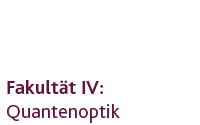Experimental Quantum Optics Chair
Welcome to the Experimental Quantum Optics Chair of Prof. Dr. Ch. Wunderlich at the University of Siegen.
Our experimental and theoretical work concentrates on the development and exploration of new schemes for quantum information processing using individual atoms and open fundamental questions related to quantum physics.
News
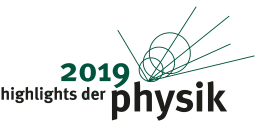
Computational art with quantum tricks
05/27/2020
From September 16 to 21, 2019, the highlights of physics in Bonn focused on how current physics research succeeds in making the invisible visible. The heart of the science festival under the motto "Show yourself" was an interactive exhibition on Münsterplatz. At each of the approximately 40 exhibits, scientists from Bonn and all over Germany were available for questions, explanations and discussions. With our contribution "Rechenkunst mit Quantentricks" we were able to show the basics of a quantum computer based on stored ions in a generally understandable way. The live demonstration of a functioning Paul trap, named after the former Bonn Professor Wolfgang Paul, invited to lively discussions on the topic of quantum computing. There were also science shows, live experiments, the Einstein Slam, a junior lab, workshops, a competition for schoolchildren, numerous lectures and lots of science to touch and try out.
Engineering a Scalable Quantum Information Proccessor
10/29/2018

The realization of a quantum computer requires interdisciplinary efforts in the field of basic research and engineering. That is why we organize a workshop in cooperation with Dr. Ing. Degenhardt from Forschungszentrum Jülich in the period from 23.04.19 to 26.04.19 in the Physikzentrum Bad Honnef.
Quantum computers, once available for widespread use, will revolutionize the ways we generate and use new knowledge – of fundamental scientific nature and for a wide range of applications. The quest for a scalable quantum computer is as of yet largely driven by experts in physics and in computer science. The challenges posed by this task, however, will necessarily require in addition dedicated and target-driven efforts in engineering. Vigorous innovative research and development in various fields of engineering will be pivotal for advancing successfully on the route towards a quantum computer, or quantum simulator, that is able of solving problems that, for all practical purposes, are intractable on classical computers. This workshop will bring together researchers already active at the forefront of this rapidly developing field, both from fundamental science and from engineering. It will put emphasis on implementations of quantum computing and quantum simulation using semiconductors, superconducting structures, and trapped atomic ions as physical systems.
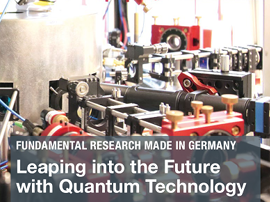
Leaping into the future with quantum technologies
07/23/2018
The CEO of the IT security company secunet AG, Rainer Baumgart, visited our group for the recent issue of their customer magazine "secuview".
Together with Prof. Christof Wunderlich (Siegen) and Prof. Dieter Meschede (Bonn) he discussed current developments and the state of the art of quantum technologies in the context of IT security.
Issue 1|2018 of "secuview" features an article about the visit and the discussions.
"Quantum technology is currently one of the hottest topics in science and technology. In particular, the development of quantum computers is the subject of much discussion, and if these innovative computers one day become very powerful, cryptography once more will have to reinvent itself from the ground up. With quantum computers (among many other applications) threatening cryptographic processes which are commonplace today, the aim of research into quantum communication is to develop new, highly secure encryption methods. What many people do not know is that cutting-edge research on quantum technologies is taking place in the heart of Germany. secuview visited two of the most influential scientists in this field – Professor Dieter Meschede and Professor Christof Wunderlich – who are conducting fundamental research with very different objectives." - secuview 1|2018
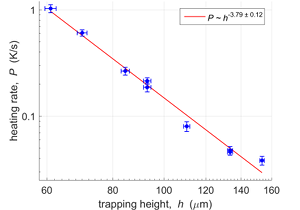
Investigation of the anomalous heating of trapped ions
01/12/2018
A major obstacle in the way of miniaturisation of ion traps,
desired for many aspects of trapped ion quantum information
processing, is anomalous heating. This is heating of the ion's
motion via electric field fluctuations of the trap electrodes.
These fluctuations are orders of magnitude stronger than
expected from Johnson noise. The reason for that is mostly
associated with surface contamination/oxidation, however the
actual mechanism behind this phenomenon is not understood so
far, hence the heating is called "anomalous".
One of the ways to shed light onto the anomalous heating
mechanism is the study of the ion's heating rate dependence on
the ion-electrode distance.
We have built a unique planar ion trap with tuneable
ion-surface separation and measured this dependence directly
for the first time. Our measurements yield a dependence in
reasonable agreement with a power law of exponent -4 that is
predicted by some theories.
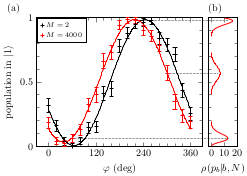
High-fidelity transport of quantum information using trapped ions
01/02/2018
A promising scheme for scalable trapped-ion quantum simulators and processors rely on assembling a larger system from smaller modules between which quantum information is exchanged. This exchange can be realized by physical transport of the ions as carriers of quantum information between those modules. The transport operations have to be performed with high-fidelity to meet the requirements of efficient error correction that is needed for scalability.
We report for the first time physical transport of quantum information encoded into trapped ion qubits with a fidelity 99.9994%, that is, well above a commonly accepted error correction threshold.
In our experiment we embedded ion transport into Ramsey measurements and compared the results for different numbers of transport operations.
During the measurements a single Ytterbium ion was transported up to 4000 times over a distance of 280 micrometer in a microstructured ion trap.
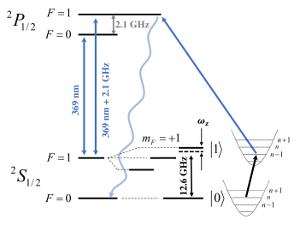
Direct and sympathetic sideband cooling using RF radiation
11/22/2017
Laser cooling is a well-established technique in which the random motion or the temperature of neutral or charged atoms and molecules is reduced by dissipative optical radiation forces. Doppler cooling and sideband cooling methods are routinely used to cool these particles close to their vibrational ground state. This is often a prerequisite for experiments in quantum optics and quantum information science.
Recent years have witnessed the emergence of long-wavelength radiation in the radio frequency (RF) regime as an alternative for ground state cooling.
We investigate RF sideband cooling in which RF radiation is applied to the bare ionic states of one and two trapped ions exposed to a static magnetic field gradient.
Our method showcases experimental simplicity avoiding the necessity of any additional dressing field.
In addition, this cooling method is demonstrated at a low trap frequency that is often encountered also in neutral atom traps, thereby giving perspective to the application in ground state cooling of neutral atoms.
Furthermore, we demonstrate the first realization of sympathetic RF sideband cooling of a two ion crystal. A Doppler cooled ion (target ion) in the crystal is further cooled by applying RF sideband cooling on the second identical Doppler cooled ion (refrigerant ion). This complements the conventional sympathetic cooling using lasers.
- Radio frequency sideband cooling and sympathetic cooling of trapped ions in a static magnetic field gradient, T. Sriarunothai et al., Journal of Modern Optics DOI:10.1080/09500340.2017.1401137 (2017)
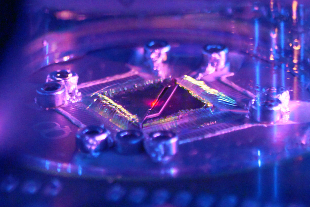
The Quantumrevolution - ARTE sciencemagazine visited our group
09/05/2017
ARTE sciencemagazine Xenius visited our group for it's newest episode Die Quantenrevolution: Wie sie unsere digitale Welt verändert.
For their journalistic research on tap-proof communications, high performance computers, that outperform todays super-computers, and GPS systems accurate on the centimeter scale, the team asked itself "What is this new quantum technology and why the world-wide race for it's realization?".
To get answers the magazine visited the research groups of Prof. Rainer Blatt in Innsbruck, Prof. Anton Zeilinger in Wien and Prof. Christof Wunderlich in Siegen.
Prof. Christof Wunderlich explained clearly how a quantum computer is able to perform tremendous amounts of parallel computations by using qu(antum)bits instead of classical bits and presented our research regarding miniaturization and streamlining of quantum technology.
The (german) episode is airing on 08.09.2017, 16:50h on ARTE and will be available online.
- Online: Die Quantenrevolution ― Xenius - Das Wissensmagazin auf ARTE (german)
- TV: 08.09.2017 16:50h - ARTE
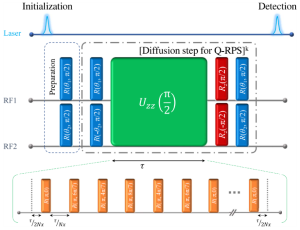
Machine learning on an ion trap quantum processor
09/05/2017
In collaboration with the University of Innsbruck (Austria), IQOQI Vienna (Austria) and the Max-Planck-Institute for Quantum Optics in Munich, we realized a proof-of-principle experiment that combines novel
concepts from artificial intelligence with the potential of ion trap
quantum computers.
In the very first experimental
demonstration of a quantum-enhanced reinforcement learning system, we investigate a quantum learning agent in a rapidly changing
environment. In the framework of the projective simulation model of
reinforcement learning, we demonstrate a generic speed-up in the agent's
decision-making/deliberation time in a system of two
radiofrequency-driven trapped ion qubits.
The quantum algorithm
underlying the deliberation process is essentially a Grover-like
algorithm, which we implemented efficiently using single-qubit rotations
and two-qubit conditional quantum dynamics.
Within experimental
uncertainties, our results confirm that the decision-making process of
the quantum learning agent is quadratically faster compared to
classical learning agents.
This experiment highlights the
potential of a scalable ion trap quantum computer in the field of
quantum-enhanced learning and artificial intelligence.
- Speeding-up the decision making of a learning agent using an ion trap quantum processor, T. Sriarunothai et al., arXiv: 1709.01366 (2017)
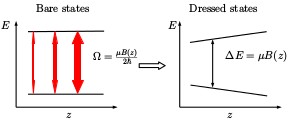
Insights on Quantum Dynamics in Magnetic Field Gradients
08/21/2017
Novel ion traps that employ magnetic gradient fields allow for the application of conditional quantum logic, the essential prerequisite for quantum computing, by the use of radio-frequency radiation that can be generated by off-the-shelf electronics.
We show that the Hamiltonian describing the necessary couplings in the presence of a resonant dynamic gradient, is identical, in a dressed state basis, to the Hamiltonian in the case of a static gradient.
The coupling strength is in both cases described by the same effective Lamb-Dicke parameter.
Our insights can be used to overcome demanding experimental requirements when using a dynamic gradient field for state-of-the-art experiments with trapped ions, for example, in quantum information science.
At the same time, we show new experimental perspectives by way of using a single dynamic gradient field, inducing long-range coupling, for conditional multi-qubit dynamics.
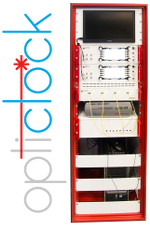
Kickoff for the optIclock pilot project
05/01/2017
On May 1st 2017 started the first pilot project Optische Einzelionenuhr für Anwender (optIclock) (user-operable optical single ion clock) in the QUTEGA initiative of Germany's Federal Ministry of Education and Research (BMBF). With a network of scientific researchers from Physikalisch-Technischen Bundesanstalt Braunschweig, Universität Bonn and Ferdinand-Braun-Institut Berlin and industry partners High Finesse GmbH, Menlo Systems GmbH, QUARTIQ GmbH, Qubig GmbH, TOPTICA Photonics AG and Vacom GmbH, it is our goal to realize a demonstrator for an optical single ion clock within the next three years. optIclock (optical Ion clock) will be designed for precision of 10-15 bis 10-17 and thus surpass every commercially available frequency standard. Yet it is meant to be transportable, easy to use and therefore end-user operable - in contrast to the current optical clocks operated by research facilities. In the optIclock a single charged atom is held in an electrodynamical trap, laser-cooled down to a few thousands of a degree Celsius above absolute zero and interrogated by a so-called clock-laser, that is stabilized to an optical transition of the atom for a high-precision frequency measurement. Usability for an end-user is of particular importance for this pilot project and will be realized through miniaturization, automatization and integration of all device's single components into a profound system architecture.
- Project website: www.opticlock.de
- Website of the BMBF quantumtechnology initiative: www.qutega.de
